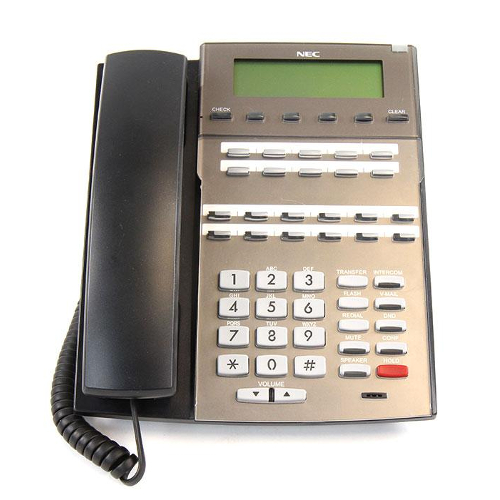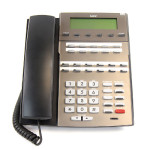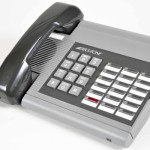Proven reliable and cost-effective, NEC DSX business phones make great additions to business offices both…
Using Speed Dials On The NEC DSX Phone
Speed Dial gives an extension user quick access to frequently called numbers, and with NEC DSX phones, there are two types: System and Personal. Speed Dial numbers can be up to 32 digits long, using 0-9, # and *, and they can have a programmed name up to 18 characters long. The name shows in the telephone display as the Speed Dial number dials out.
Speed Dial can store outside numbers and Intercom digits. The capability to store Intercom digits provides the user with “one-touch” access to features they use most often. For example, a user can have a Speed Dial bin that simplifies forwarding calls to voice mail or a co-worker.
About System Speed Dial
System Speed Dial gives every extension access to the same set of stored numbers. Depending on the system option selected, the system provides either 10, 100, or 1000 System Speed Dial numbers.
About Personal Speed Dial
Personal Speed Dial provides extensions with 20 numbers stored privately for their own use. The Personal Speed Dial keys on a DSS Console access the same bins as the extension to which it is attached.
Unique Speed Dial Entries
In addition to the digits 0-9, # and *, you can enter the following for additional dialing options.
- For system programming:
- Press Feature Key 1 for Flash
- Press Feature Key 2 for Wait
- Press Feature Key 3 for Pause
- For user programming:
- Press FLASH for Flash
- Press N/A for Wait
- Press MUTE for Pause
Storing Line Routing in a Speed Dial Bin
When you program a Speed Dial bin, you can select either a line or a Line Group over which the call should route. For example, you can enter 1 for line 1 or 90 for Line Group 90.
- If you enter a Line Group number, the system will follow the Line Group programming and select an available line in the group for the call.
- If you enter a line number and the line is busy when the Speed Dial bin tries to dial out, the user hears a busy tone. If their extension has Line Queuing, they can dial 2 to queue for a line to become free. If they hang up, the system converts the queue to a Line Callback.
- The capability to dial 90-98 to select a Line Group for a Speed Dial call is a permanent feature and not affect by programming.
Centrex Compatibility
Speed Dial offers unique compatibility with connected Centrex services. A Speed Dial number can accommodate both placing a new call and outdialing the stored Speed Dial number on an active Centrex line. This enables features such as Centrex Transfer and Conference. Speed Dial adheres to the following rules:
1. When a user active on an outside call presses TRANSFER and selects a Speed Dial number (using any method), the system examines the contents of the stored Speed Dial bin.
2. If the first entry in the bin is an F (Flash command), the system flashes the connected line and outdials the contents of the bin (ignoring the line selection associated with the bin).
- Note that this unique Centrex integration also pertains to voice mail ports accessing stored Speed Dial numbers.
Chaining Bins for Dialing Long Numbers
A Speed Dial number can be up to 32 digits long. The system allows this by automatically using the next adjacent bin for entries longer than 16 digits. For example, assume you want to store a Personal Speed Dial number for a banking service (203-926-5400) followed by a pause and your 10 digits customer code (9876543210). If you store the entries in bin 701, the following occurs:
- The system stores the first 16 digits (203 926 5400 Pause 98765) in bin 701.
- The system stores the remaining digits (43210) in bin 702.
Chaining Notes:
- In the above example, bin 702 is inaccessible for viewing, programming, or dialing. It only becomes available if you reprogram bin 701 to be 16 digits or less.
- Since bin 720 is the last Personal Speed Dial bin, it can only contain 16 digits.
Personal Speed Dial
- To program a Personal Speed Dial number:
1. Do not lift the handset or press any keys.
2. Dial #SP (#77).
3. Do one of the following:
a. Dial the Personal Speed Dial bin number (701-720).
b. Press a Personal Speed Dial bin key (for bins 701-710).
4. Press HOLD.
5. Do one of the following:
a. Enter the line number you want the system to use when dialing your stored number (1-64).
b. Enter the Line Group number you want the system to use when dialing your stored number (90-98).
c. Press INTERCOM if you want to enter Intercom codes.
6. Press HOLD.
7. Enter the number you want to store (up to 32 digits long).
- If storing Intercom codes, you can enter a valid dial sequence using the digits 0-9, # and *.
- To insert a pause, press MUTE. To insert a Flash, press FLASH.
- Do not enter a pause or flash into an Intercom code.
8. Press HOLD.
9. Enter a name for the Speed Dial number.
10. Press HOLD.
11. Do one of the following:
a. Repeat from step 3 to program another bin.
b. Press SPEAKER to exit.
- To dial a stored Personal Speed Dial number:
1. Do one of the following:
a. Press INTERCOM, dial #, and then dial the Personal Speed Dial bin number (701-720).
b. Press bin key for bins 701-710.
c. Press a Feature Key set up as a Personal Speed Dial key.
2. Optional:
- To chain bins, wait for the first bin to dial out, and then press a bin key or Feature Key.
- If the programmed route is busy, press an idle line key to reroute the call.
- You cannot chain Intercom numbers.
System Speed Dial
- To program a System Speed Dial number:
1. Do not lift the handset or press any keys.
2. Dial #SP (#77).
3. Dial the System Speed Dial bin number (normally 200-299).
4. Press HOLD.
5. Do one of the following:
a. Enter the line number you want the system to use when dialing your stored number (1-64).
b. Enter the Line Group number you want the system to use when dialing your stored number (90-98).
c. Press INTERCOM.
6. Press HOLD.
7.Enter the number you want to store (up to 32 digits long).
If storing Intercom codes, you can enter a valid dial sequence using the digits 0-9, # and *.
To insert a pause, press MUTE. To insert a Flash, press FLASH.
Do not enter a pause or flash into an Intercom code.
8. Press HOLD.
9. Enter a name for the Speed Dial number.
10. Press HOLD.
11. Do one of the following:
a. Repeat from step 3 to program another bin.
b. Press SPEAKER to exit.
- To dial a stored System Speed Dial number:
1. Do one of the following:
a. Press INTERCOM, dial #, and then dial the System Speed Dial bin number (normally 200-299).
b. Press a Feature Key set up as a System Speed Dial key.
2. Optional:
a. To chain bins, wait for the first bin to dial out, and then press a bin key or Feature Key.
b.If the programmed route is busy, press an idle line key to reroute the call.
And that is how you program and dial both Personal and System Speed Dials. If you have any questions, please contact your System Administrator.
If you are looking for cost-effective, new and refurbished NEC DSX business phones and other telephone system equipment, please visit Startechtel.com or call 800-564-8045. You can also connect with us on Facebook, Google+, Twitter, LinkedIn, and Pinterest.






Related Posts
-
The Hold Feature On The NEC DSX Phone System
- Programming Instructions For Business Phone NEC DTERM 80
The NEC Dterm 80 phone boasts a variety of convenient and useful features. A 3…
-
Programming System Speed Dials On The Executone IDS M18 Phone
Speed Dial provides an easy way to access and dial phone numbers that are often…
Tags: How to, NEC DSX 22-Button phone, Personal speed dial, Program Speed Dials, System Speed Dial
Categories
- Aastra phones
- Allworx
- Avaya
- Avaya Legend
- Broadband Solutions
- Business Communications
- Business Phone Systems
- Business Tips
- Business Trends
- Cell Phone Usage
- Cisco
- Comdial Phones
- Community Events
- Conference Phones
- Executone
- Grandstream Business Phones
- Headsets
- Holidays
- Intertel Phones
- IP/VoIP Phones
- Iwatsu Phones
- M-Series Norstar Phones
- Maintenance Tips
- Mitel Phones
- Mitel Superset
- Mobile Apps
- NEC Business Phones
- Networking
- Networking Equipment
- Nortel Meridian Phones
- Nortel Networks
- Nortel Norstar Phones
- Panasonic Business Phone Systems
- Phone System Equipment
- Phone System Repair & Installation
- Phone Systems
- Polycom
- Programming Your Phone System
- Refurbished Phone System Equipment
- Refurbished Phones Systems
- Sales & Promotions
- Security Tips
- Siemens Phones
- SIP Trunking
- Starplus STS Phones
- Tadiran
- Telecom News
- Toshiba DKT Series Business Phones
- Toshiba Phones
- Training Videos
- Uncategorized
- Unified Communications
- Useful Apps
- Video Conference
- Video Conferencing
- Video Tutorials
- Vodavi Phone Systems
- VoIP Phone Systems
Archives
- November 2019
- October 2019
- September 2019
- August 2019
- July 2019
- June 2019
- May 2019
- April 2019
- March 2019
- February 2019
- January 2019
- December 2018
- November 2018
- October 2018
- September 2018
- August 2018
- July 2018
- June 2018
- May 2018
- April 2018
- March 2018
- February 2018
- January 2018
- December 2017
- November 2017
- October 2017
- September 2017
- August 2017
- July 2017
- June 2017
- May 2017
- April 2017
- March 2017
- February 2017
- January 2017
- December 2016
- November 2016
- October 2016
- September 2016
- August 2016
- July 2016
- June 2016
- May 2016
- April 2016
- March 2016
- February 2016
- January 2016
- December 2015
- November 2015
- October 2015
- September 2015
- August 2015
- July 2015
- June 2015
- May 2015
- April 2015
- March 2015
- February 2015
- January 2015
- December 2014
- November 2014
- October 2014
- September 2014
- August 2014
- July 2014
- June 2014
- May 2014
- April 2014
- March 2014
- February 2014
- January 2014
- December 2013
- November 2013
- October 2013
- September 2013
- May 2013
- April 2013
- March 2013
- January 2013
- December 2012
- November 2012
- October 2012
- September 2012
- August 2012
- July 2012
- December 2011
- August 2011
- July 2011
- April 2011
- March 2011
- February 2011
- January 2011








